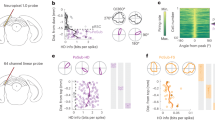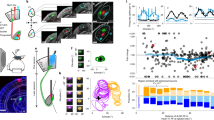Abstract
Cells in cerebral cortex fail to respond to fast-moving stimuli that evoke strong responses in the thalamic nuclei innervating the cortex. The reason for this behavior has remained a mystery. We study an experimentally motivated model of the thalamic input-recipient layer of cat primary visual cortex that accounts for many aspects of cortical orientation tuning. In this circuit, inhibition dominates over excitation, but temporal modulations of excitation and inhibition occur out of phase with one another, allowing excitation to transiently drive cells. We show that this circuit provides a natural explanation of cortical low-pass temporal frequency tuning, provided N-methyl-d-aspartate (NMDA) receptors are present in thalamocortical synapses in proportions measured experimentally. This suggests a new and unanticipated role for NMDA conductances in shaping the temporal response properties of cortical cells, and suggests that common cortical circuit mechanisms underlie both spatial and temporal response tuning.
This is a preview of subscription content, access via your institution
Access options
Subscribe to this journal
Receive 12 print issues and online access
$209.00 per year
only $17.42 per issue
Buy this article
- Purchase on Springer Link
- Instant access to full article PDF
Prices may be subject to local taxes which are calculated during checkout



Similar content being viewed by others
References
DeAngelis, G. C., Ohzawa, I. & Freeman, R. D. Spatiotemporal organization of simple-cell receptive fields in the cat's striate cortex. I. General characteristics and postnatal development. J. Neurophysiol. 69, 1091–1117 (1993).
Holub, R. A. & Morton-Gibson, M. Response of visual cortical neurons of the cat to moving sinusoidal gratings: response-contrast functions and spatiotemporal interactions. J. Neurophysiol. 46, 1244–1259 (1981).
Movshon, J. A., Thompson, I. D. & Tolhurst, D. J. Spatial and temporal contrast sensitivity of neurones in areas 17 and 18 of the cat's visual cortex. J. Physiol. (Lond.) 283, 101–120 (1978).
Saul, A. B. & Humphrey, A. L. Temporal-frequency tuning of direction selectivity in cat visual cortex. Vis. Neurosci. 8, 365–372 (1992).
Ikeda, H. & Wright, M. J. Spatial and temporal properties of sustained and transient neurones in area 17 of the cat's visual cortex. Exp. Brain Res. 22, 363–383 (1975).
Hawken, M. J., Shapley, R. M. & Grosof, D. H. Temporal-frequency selectivity in monkey visual cortex. Vis. Neurosci. 13, 477–492 (1996).
O'Keefe, L. P., Levitt, J. B., Kiper, D. C., Shapley, R. M. & Movshon, J. A. Functional organization of owl monkey lateral geniculate nucleus and visual cortex. J. Neurophysiol. 80, 594–609 (1998).
Derrington, A. M. & Fuchs, A. F. Spatial and temporal properties of X and Y cells in the cat lateral geniculate nucleus. J. Physiol. (Lond.) 293, 347–364 (1979).
Hamamoto, J., Cheng, H., Yoshida, K., Smith, E. L. & Chino, Y. M. Transfer characteristics of lateral geniculate nucleus X-neurons in the cat: effects of temporal frequency. Exp. Brain Res. 98, 191–199 (1994).
Saul, A. B. & Humphrey, A. L. Spatial and temporal response properties of lagged and nonlagged cells in cat lateral geniculate nucleus. J. Neurophysiol. 64, 206–224 (1990).
Sclar, G. Expression of “retinal” contrast gain control by neurons of the cat's lateral geniculate nucleus. Exp. Brain Res. 66, 589–596 (1987).
Creutzfeldt, O., Hellweg, F. C. & Schreiner, C. Thalamocortical transformation of responses to complex auditory stimuli. Exp. Brain Res. 39, 87–104 (1980).
Simons, D. J. Temporal and spatial integration in the rat SI vibrissa cortex. J. Neurophysiol. 54, 615–635 (1985).
Troyer, T. W., Krukowski, A. E., Priebe, N. J. & Miller, K. D. Contrast-invariant orientation tuning in cat visual cortex: thalamocortical input tuning and correlation-based intracortical connectivity. J. Neurosci. 18, 5908–5927 (1998).
Ferster, D. Spatially opponent excitation and inhibition in simple cells of the cat visual cortex. J. Neurosci. 8, 1172–1180 (1988).
Hirsch, J. A., Alonso, J. M., Reid, R. C. & Martinez, L. M. Synaptic integration in striate cortical simple cells. J. Neurosci. 18, 9517–9528 (1998).
Ferster, D. & Jagadeesh, B. EPSP–IPSP interactions in cat visual cortex studied with in vivo whole-cell patch recording. J. Neurosci. 12, 1262–1274 (1992).
Maex, R. & Orban, G. A. A model circuit for cortical temporal low-pass filtering. Neural Comput. 4, 932–945 (1992).
Suarez, H., Koch, C. & Douglas, R. Modeling direction selectivity of simple cells in striate visual cortex within the framework of the canonical microcircuit. J. Neurosci. 15, 6700–6719 (1995).
Gil, Z. & Amitai, Y. Adult thalamocortical transmission involves both NMDA and non-NMDA receptors. J. Neurophysiol. 76, 2547–2554 (1996).
Crair, M. C. & Malenka, R. C. A critical period for long-term potentiation at thalamocortical synapses. Nature 375, 325–328 (1995).
Fox, K., Sato, H. & Daw, N. The location and function of NMDA receptors in cat and kitten visual cortex. J. Neurosci. 9, 2443–2454 (1989).
Armstrong-James, M., Welker, E. & Callahan, C. A. The contribution of NMDA and non-NMDA receptors to fast and slow transmission of sensory information in the rat SI barrel cortex. J. Neurosci. 13, 2149–2160 (1993).
Salt, T. E., Meier, C. L., Seno, N., Krucker, T. & Herrling, P. L. Thalamocortical and corticocortical excitatory postsynaptic potentials mediated by excitatory amino acid receptors in the cat motor cortex in vivo. Neuroscience 64, 433–442 (1995).
Kasamatsu, T. et al. Roles of N-methyl-D-aspartate receptors in ocular dominance plasticity in developing visual cortex: re-evaluation. Neuroscience 82, 687–700 (1998).
Miller, K. D., Chapman, B. & Stryker, M. P. Visual responses in adult cat visual cortex depend on N-methyl-D-aspartate receptors. Proc. Natl. Acad. Sci. USA 86, 5183–5187 (1989).
Hagihara, K., Tsumoto, T., Sato, H. & Hata, Y. Actions of excitatory amino acid antagonists on geniculo-cortical transmission in the cat's visual cortex. Exp. Brain Res. 69, 407–416 (1988).
Ling, D. S. & Benardo, L. S. Recruitment of GABAA inhibition in rat neocortex is limited and not NMDA dependent. J. Neurophysiol. 74, 2329–2335 (1995).
Angulo, M. C., Rossier, J. & Audinat, E. Postsynaptic glutamate receptors and integrative properties of fast-spiking interneurons in the rat neocortex. J. Neurophysiol. 82, 1295–1302 (1999).
Chance, F. S., Nelson, S. B. & Abbott, L. F. Synaptic depression and the temporal response characteristics of V1 cells. J. Neurosci. 18, 4785–4799 (1998).
Carmignoto, G. & Vicini, S. Activity-dependent decrease in NMDA receptor responses during development of the visual cortex. Science 258, 1007–1011 (1992).
Gary-Bobo, E., Przybyslawski, J. & Saillour, P. Experience-dependent maturation of the spatial and temporal characteristics of the cell receptive fields in the kitten visual cortex. Neurosci. Lett. 189, 147–150 (1995).
McCormick, D. A., Connors, B. W., Lighthall, J. W. & Prince, D. A. Comparative electrophysiology of pyramidal and sparsely spiny stellate neurons of the neocortex. J. Neurophysiol. 54, 782–806 (1985).
Feldmeyer, D., Egger, V., Lubke, J. & Sakmann, B. Reliable synaptic connections between pairs of excitatory layer 4 neurones within a single 'barrel' of developing rat somatosensory cortex. J. Physiol. (Lond.) 521, 169–190 (1999).
Abbott, L. F., Varela, J. A., Sen, K. & Nelson, S. B. Synaptic depression and cortical gain control. Science 275, 220–224 (1997).
Tsodyks, M. V. & Markram, H. The neural code between neocortical pyramidal neurons depends on neurotransmitter release probability. Proc. Natl. Acad. Sci. USA 94, 719–723 (1997).
Catalano, S. M., Chang, C. K. & Shatz, C. J. Activity-dependent regulation of NMDAR1 immunoreactivity in the developing visual cortex. J. Neurosci. 17, 8376–8390 (1997).
Thomson, A. M. & Destexhe, A. Dual intracellular recordings and computational models of slow inhibitory postsynaptic potentials in rat neocortical and hippocampal slices. Neuroscience 92, 1193–1215 (1999).
Douglas, R. J. & Martin, K. A. A functional microcircuit for cat visual cortex. J. Physiol. (Lond.) 440, 735–769 (1991).
Allison, J. D., Kabara, J. F., Snider, R. K., Casagrande, V. A. & Bonds, A. B. GABAB-receptor-mediated inhibition reduces the orientation selectivity of the sustained response of striate cortical neurons in cats. Vis. Neurosci. 13, 559–566 (1996).
Cai, D., DeAngelis, G. C. & Freeman, R. D. Spatiotemporal receptive field organization in the lateral geniculate nucleus of cats and kittens. J. Neurophysiol. 78, 1045–1061 (1997).
Quinlan, E. M., Olstein, D. H. & Bear, M. F. Bidirectional, experience-dependent regulation of N-methyl-D-aspartate receptor subunit composition in the rat visual cortex during postnatal development. Proc. Natl. Acad. Sci. USA 96, 12876–12880 (1999).
Fox, K., Daw, N., Sato, H. & Czepita, D. The effect of visual experience on development of NMDA receptor synaptic transmission in kitten visual cortex. J. Neurosci. 12, 2672–2684 (1992).
Czepita, D., Reid, S. N. & Daw, N. W. Effect of longer periods of dark rearing on NMDA receptors in cat visual cortex. J. Neurophysiol. 72, 1220–1226 (1994).
Tang, Y. P. et al. Genetic enhancement of learning and memory in mice. Nature 401, 63–69 (1999).
Swadlow, H. A. Efferent neurons and suspected interneurons in S-1 vibrissa cortex of the awake rabbit: receptive fields and axonal properties. J. Neurophysiol. 62, 288–308 (1989).
Swadlow, H. A. Efferent neurons and suspected interneurons in second somatosensory cortex of the awake rabbit: receptive fields and axonal properties. J. Neurophysiol. 66, 1392–1409 (1991).
Swadlow, H. A. Efferent neurons and suspected interneurons in motor cortex of the awake rabbit: axonal properties, sensory receptive fields, and subthreshold synaptic inputs. J. Neurophysiol. 71, 437–453 (1994).
Pinto, D. J., Brumberg, J. C. & Simons, D. J. Circuit dynamics and coding strategies in rodent somatosensory cortex. J. Neurophysiol. 83, 1158–1166 (2000).
Jahr, C. E. & Stevens, C. E. Voltage dependence of NMDA-activated macroscopic conductances predicted by single-channel kinetics. J. Neurosci. 10, 3178–3182 (1990).
Acknowledgements
We thank T. Troyer for discussions and L. Stone for comments on the manuscript. Supported by a Howard Hughes Medical Institute predoctoral fellowship (A.E.K.) and by RO1EY001 from the National Eye Institute (K.D.M.).
Author information
Authors and Affiliations
Corresponding authors
Supplementary information
Rights and permissions
About this article
Cite this article
Krukowski, A., Miller, K. Thalamocortical NMDA conductances and intracortical inhibition can explain cortical temporal tuning. Nat Neurosci 4, 424–430 (2001). https://doi.org/10.1038/86084
Received:
Accepted:
Issue Date:
DOI: https://doi.org/10.1038/86084
This article is cited by
-
Distribution of correlated spiking events in a population-based approach for Integrate-and-Fire networks
Journal of Computational Neuroscience (2014)
-
Dynamics of spiking neurons: between homogeneity and synchrony
Journal of Computational Neuroscience (2013)
-
Temporal plasticity in the primary auditory cortex induced by operant perceptual learning
Nature Neuroscience (2004)
-
Receptive-field construction in cortical inhibitory interneurons
Nature Neuroscience (2002)



